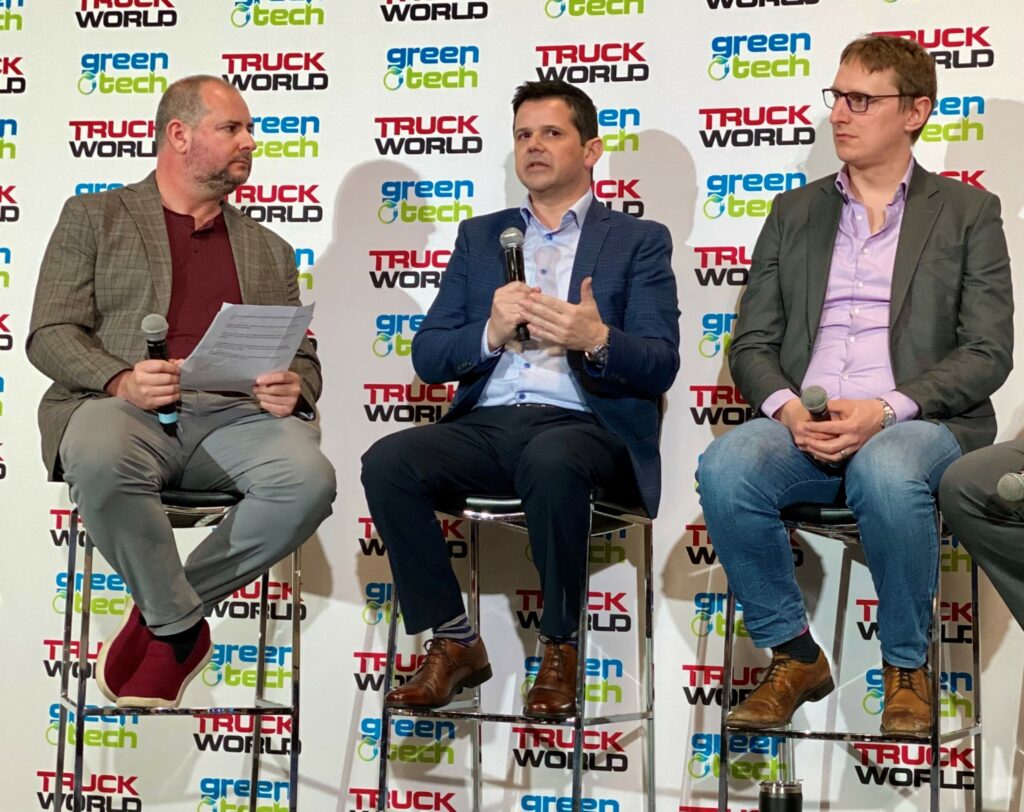Charging infrastructure planning, phased approach vital for EV transition
Get charging infrastructure ready in advance and use a phased approach to transition to electric vehicles, early adopters of electrification advise.
Carriers must focus on the energy management challenge, so all stakeholders are on the same page, said Joe Lombardo, vice-president of network operations at Purolator, during a discussion at Truck World where early EV adopters highlighted their successes and challenges.
“Vehicles are readily available, it’s the infrastructure that takes time,” he said. Be prepared for 12 to 24 months of lead time before operations commence.

Mike Skirzynski, fleet electrification advisor, PowerON Energy Solutions, advocated a phased approach to electrify a fleet. “You don’t take a big bang approach to electrification,” he said. Take time and plan, so if issues arise, they are limited to a smaller scale. The lessons learned can be utilized to scale up.
Change management is also a big part of the equation. Fleet operations, facilities maintenance that could work independently now have to work together on new technology. Clarifying who is doing what during transition prevents issues from arising.
Purolator gets feedback from its frontline couriers who drive the EVs. Drivers already know how to drive, they want to know what’s different about electric vehicles, Lombardo said.
Cold weather operations
Cold weather in Canada can be tough on batteries, and there has been reticence about EV adoption. Carriers must consider range degradation due to cooler weather.
Skirzynski advised conservative estimates when setting up routes to avoid surprises down the road. Battery preconditioning is vital while the vehicle is plugged into a charger to preserve range, he added.
Purolator has operated EVs in Quebec City in -8 to -20 C conditions for several weeks. There is range degradation, Lombardo said, and it is important to anticipate the issue.
Behind the fence charging works for certain routes, but for longer trips, the courier company will plan mid-shift charge points to ensure vehicles can return to base.
“The majority of routes we do are under 100 km a day and most available vehicles can run 300-400 km, we can manage with that,” he said.
Planning for the future
Using Class 8 EVs is on Purolator’s roadmap as it plans to introduce pilot studies. The company will also look at how yard trucks fit into the equation. Putting more packages in vehicles and optimizing routes provides more payload per mile for the carbon emitted.
Companies buy the trucks and it’s the drivers who are at the sharp end of the stick. Skirzynski said there were mixed and even some negative reactions during the implementation phase. Fast forward to the present and the uptake of EVs has gone up in employees’ personal four-wheelers because people love them, he said.
Lombardo said feedback has been extremely positive among couriers. Drivers are competing among themselves to see who returns to base with the most range, using regenerative braking and other positive driving habits.
Incentivizing electrification
Technology costs money and electric vehicles are not cheap. Incentives help fleets adopt electrification. Lombardo acknowledges that Purolator has tapped into these incentives but recognizes they will not be around forever. He noted that the price point in the light-duty segment is getting to a place where the business is viable. Public charging infrastructure would also help ease the cost of operations, he added.
On the maintenance side, the EVs come into the shop less frequently than internal combustion energy vehicles. The obvious benefit is the reduction of brake consumption and use. Purolator has been using 100 EVs for the past year and tire wear and tear is yet to be determined, Lombardo said.
Residual value
He expects maintenance expenses to come down but said technicians need to be upskilled. Charging equipment also needs to be maintained, and this adds to costs.
And as the EVs progress through their lifecycle, fleets must decide when it is no longer economical to maintain and operate them. Purolator said as battery range degrades, those vehicles could be deployed on shorter routes. Since the vehicles are built from aluminum and don’t corrode, batteries could be swapped out for new ones.
Long-term usage
Skirzynski sees benefits from reduced fuel costs, operational savings and clean fuel regulation credits.
When the effective state of charge of battery health drops below the 60% mark, there’s still plenty of capacity to use for stationary applications, he noted. The longer the battery can be used the better and a recycling industry is emerging that can be taken advantage of.
The secret to success, Lambardo said, is being agile and having the ability to adapt and learn as you go.
Have your say
This is a moderated forum. Comments will no longer be published unless they are accompanied by a first and last name and a verifiable email address. (Today's Trucking will not publish or share the email address.) Profane language and content deemed to be libelous, racist, or threatening in nature will not be published under any circumstances.